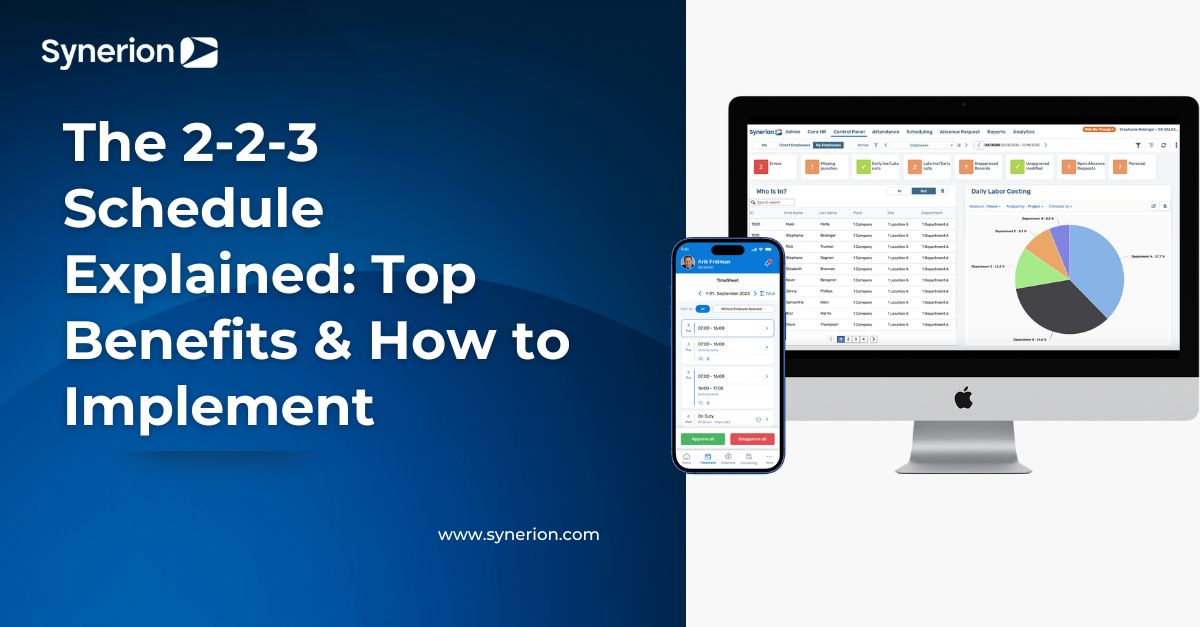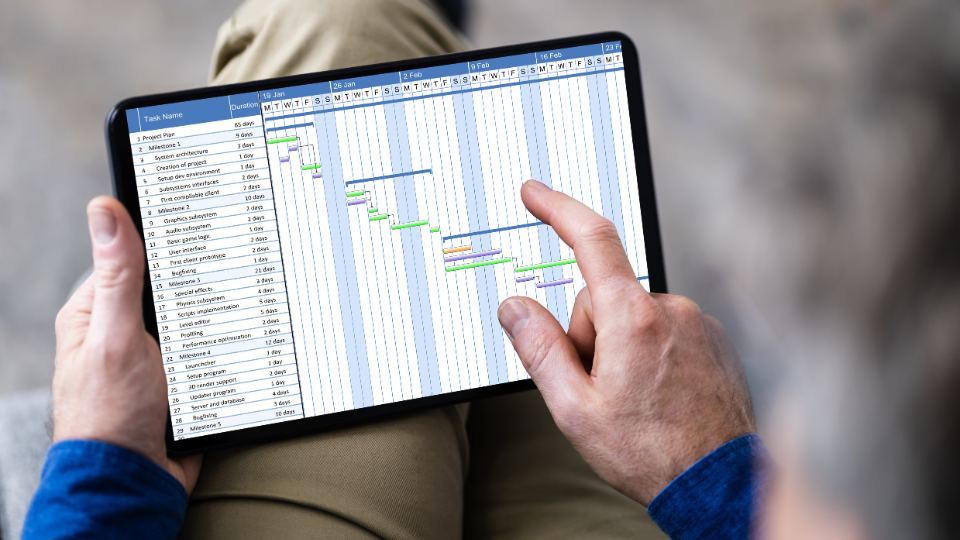
The 2-2-3 Schedule Explained: Top Benefits & How to Implement

Scheduling employees for 24/7 operations presents unique challenges. You need round-the-clock coverage, but also a structure that prevents burnout, supports work-life balance, and remains manageable for HR and operations. The 2-2-3 schedule offers a compelling alternative to the standard five-day workweek for many industries.
In this article, we'll explain how the 2-2-3 schedule works, why organizations adopt it, and how to implement it effectively using workforce management tools like Synerion.
Main Takeaways:
- The 2-2-3 schedule rotates employees through 12-hour shifts over a 14-day cycle, providing continuous coverage with frequent days off
- It supports work-life balance while reducing overtime and simplifying long-term scheduling
- Employers benefit from improved shift coverage, fewer handoff errors, and more predictable labor planning
- With platforms like Synerion, organizations can implement and manage complex shift rotations at scale, efficiently and transparently
What Is the 2-2-3 Schedule & How Does It Work?

The 2-2-3 schedule, sometimes referred to as the Panama schedule, is a rotating shift pattern commonly used in 24/7 operations. Employees work two days, take two days off, work three days, then repeat the cycle over a two-week period. Four teams rotate through this pattern to provide continuous coverage, often alternating between day and night shifts to distribute responsibilities equitably.
Benefits of the 2-2-3 Schedule for Employers and Employees

The 2-2-3 schedule is favored for its balance of operational efficiency and employee satisfaction. The model reduces strain on staff while simplifying long-term planning for management.
For employers:
- Reduced labor costs: The 2/2/3 schedule helps optimize shift coverage and minimize the need for costly overtime or emergency staffing. With four evenly distributed teams, it’s easier to match headcount to demand.
- Improved continuity: Fewer daily shift changes lead to smoother handoffs and less room for miscommunication, particularly important in high-stakes environments like healthcare or manufacturing.
- Better coverage: The rotation model ensures that staffing is consistent across all hours and days, including weekends and holidays, without overloading a single team.
- Simplified administration: Because the pattern repeats consistently, it reduces the manual burden of weekly schedule creation and helps forecast future labor needs with more accuracy.
For employees:
- Work-life balance: Having regular consecutive days off (often including full weekends) makes it easier for employees to rest, manage family commitments, or pursue outside interests.
- Predictability: The fixed, repeating rotation helps employees plan vacations, appointments, and personal time far in advance, without needing to wait for weekly shift postings.
- Reduced burnout: Because employees never work more than three consecutive days, the schedule naturally limits fatigue and allows for quicker recovery between work stretches.
- Fair distribution: All teams rotate through nights and weekends equally, helping avoid resentment or perceived favoritism in schedule assignments.
Many employees also appreciate the fact that this schedule provides seven days off in each 14-day cycle, nearly double the time off of a standard Monday–Friday workweek. That consistency and balance can lead to higher morale, better retention, and a stronger culture of trust between teams and leadership.
What Industries Use the 2-2-3 Schedule?

The 2-2-3 schedule works best in industries requiring 24/7 operations, such as:
- Healthcare: Hospitals implement the 2-2-3 shift pattern to ensure consistent patient care while giving nursing staff predictable schedules. The 2-3-2 schedule variation is sometimes used to align with specific department needs.
- Manufacturing: Factories with continuous production use the 2-2-3 rotation to maintain output while reducing worker fatigue. The 3/2 schedule might be used for specific production lines.
- Public safety: Police departments, fire stations, and emergency services rely on the 2-2-3 work schedule to ensure round-the-clock coverage while supporting officer wellness.
- Energy sector: Power plants and utilities adopt this pattern for continuous monitoring and maintenance operations.
- Transportation/Logistics: Distribution centers and transportation hubs use the 223 work schedule to keep goods moving efficiently at all hours.
Common Variations of the 2-2-3 Schedule
Many organizations adapt the core 2-2-3 structure to better fit operational needs, employee preferences, or fatigue management goals. Below are a few common variations:
How to Implement the 2-2-3 Schedule
Rolling out a 2-2-3 schedule successfully requires upfront planning, thoughtful communication, and the right tools to support the structure over time. Here's how to approach implementation with both short- and long-term success in mind.
1. Assess Staffing Requirements
Begin by determining the number of employees needed for each shift to maintain safe and efficient operations. Multiply that number by four to cover all rotating teams.
Example: If five employees are required per shift, you'll need a total of 20 team members (5 per team × 4 teams). Don't forget to account for floaters, part-time staff, or on-call roles to cover absences or spikes in demand.
2. Build and Balance Teams
Divide employees into four rotating teams with balanced skills, experience, and certifications. Consider employee preferences for day vs. night shifts, where possible, but ensure each team is self-sufficient to avoid coverage issues. In unionized environments, this stage may also involve coordination with labor representatives to align with contract agreements.
3. Communicate and Train
Transparency is essential when introducing a new schedule. Share a visual calendar showing the full 14- or 28-day rotation and hold Q&A sessions to walk through expectations, benefits, and FAQs. Be prepared to clarify why the change is being made and how it will impact things like overtime, shift swaps, and holiday coverage.
Proactively training both employees and managers ensures smoother adoption and reduces resistance or misunderstandings during rollout.
4. Use Workforce Technology to Streamline Operations
Manual scheduling is not built to handle the complexity of a 2-2-3 rotation. A workforce management solution like Synerion automates the process, giving HR and operations teams the control and visibility they need to keep shifts running smoothly.
With Synerion, you can:
- Set up automated rotating schedules and adjust them with a few clicks
- Manage shift swaps, exceptions, and time-off requests from a centralized dashboard
- Monitor labor coverage and overtime in real time
- Provide employees with mobile-friendly access to their upcoming shifts and team calendars
- Sync schedules with payroll and compliance tracking tools
Technology also helps ensure consistency across departments, especially as your workforce grows or business needs shift.
Challenges of the 2-2-3 Schedule

Despite its operational advantages, the 2-2-3 schedule introduces a few unique challenges, particularly around employee wellness and scheduling logistics. Addressing these early on will help teams adapt and thrive.
Fatigue and Sleep Disruption
Twelve-hour shifts, especially when rotating between days and nights, can be physically and mentally demanding. Most night shift workers never fully adjust their circadian rhythms. This makes fatigue management essential.
Employers should consider wellness programs, built-in breaks, and forward-rotating schedules to support recovery and retention.
Adjustment Period
Transitioning to a 2-2-3 rotation requires adjustment time. Some employees may struggle initially with the changing sleep patterns, particularly when alternating between day and night shifts. In fact, backward rotation systems are significantly associated with poor sleep quality, making a well-managed forward-rotating schedule even more critical.
Scheduling Complexity
Without proper tools, managing the initial setup and ongoing maintenance of a 2-2-3 schedule can be challenging. Time-off requests, holidays, and unexpected absences require careful planning to maintain coverage.
Digital scheduling tools like Synerion's platform simplify these challenges by automating rotations, managing exceptions, and providing clear calendars for all staff.
Best Practices for Long-Term Success
To keep your 2-2-3 schedule effective over time, you'll need to make periodic adjustments based on data and employee feedback.
Long-term tips include:
- Review scheduling data quarterly: Use reports from tools like Synerion to identify patterns in absenteeism, overtime, or shift conflicts
- Rotate team leads periodically to prevent stagnation and improve team dynamics
- Solicit employee feedback after the first 90 days and annually thereafter to uncover pain points
- Adjust for seasonality: Use scheduling data to predict when certain teams may need additional support, such as during flu season or end-of-year operations
- Keep managers aligned through regular check-ins and process refreshers to ensure policies are being applied consistently
Actively managing your schedule over time extends the benefits of the 2-2-3 model and adapts it as your organization's needs evolve.
Future-Proof Your Scheduling Strategy with Synerion
Managing the 2-2-3 schedule is easier when you have the right tools. Synerion simplifies every step, whether you're launching the schedule for the first time or fine-tuning an existing model.
With Synerion, you can:
- Automate shift rotations and conflict detection
- Streamline time-off approvals and exception handling
- Track labor costs and scheduling coverage in real time
- Provide employees with mobile access to shift calendars and change requests
Flexible scheduling doesn't just improve operations; it builds trust, reduces turnover, and helps your teams stay engaged and supported.
Ready to take control of complex scheduling? Request a demo today.
